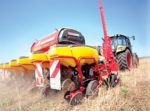Advertise Follow Us
Articles Tagged with ''Kinze''
The Next Frontier In Seed Placement Technology
From seed tubes and seed meters to ground sensors, new equipment coming on the scene can help no-tillers achieve more consistent stands and raise planting efficiency and yields.
Read More
Flat, Table-Top Fields Need Moisture-Driven Management
Illinois strip-tiller shares lessons he learned while struggling with bad weather and cold, wet fields.
Read More
Radishes Making No-Till Fields More Productive
Wisconsin no-tillers are finding radishes are valuable for breaking up compaction and producing nitrogen for the following year’s crop.
Read More
No-Till Turns Out Top Yields While Slashing Costs
Feeding crops the right amount of nutrients at the best possible time pays big dividends while protecting the environment for this Virginia family.
Read More
No-Tiller Finds A Premium Growing Edible Soybeans
Moving away from Roundup Ready soybeans allows Carrol Wyss the opportunity to earn a few extra dollars while rotating chemistries in his corn-soybean rotation.
Read More









